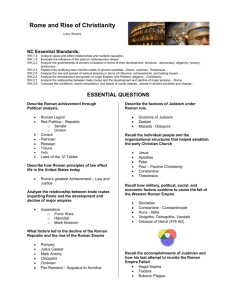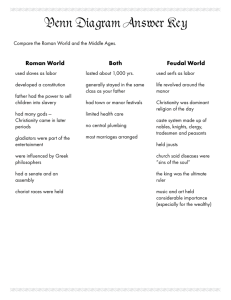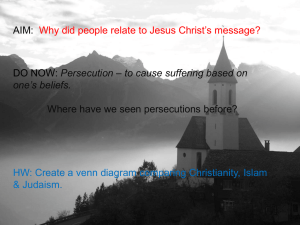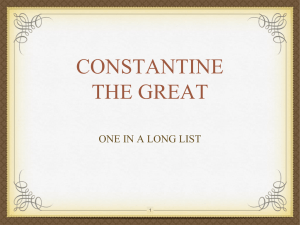The Rise of Christianity: A Historical Overview
advertisement
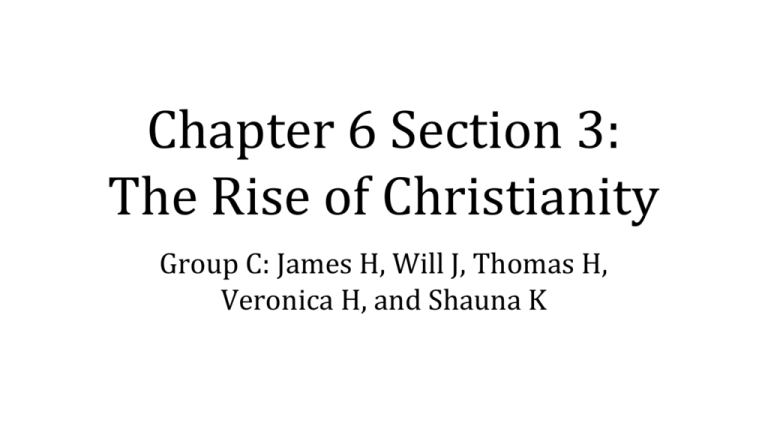
Chapter 6 Section 3: The Rise of Christianity Group C: James H, Will J, Thomas H, Veronica H, and Shauna K CHAPTER 6 SECTION 3: “The Rise of Christianity” ● MAIN IDEA ○ ● Christianity, which derived from Judaism, became a major world religion despite being repressed and developed during the fall of the Roman Empire. KEY POINTS ○ ○ ○ ○ Roman Empire ruled over the Jews Jesus’ Ideas and Life Christianity spreads through the Empire A World Religion Location ● Palestine ○ ○ ○ ● Southeastern edge of Mediterranean Sea Now part of Israel & Jordan “Holy land” - birthplace of Christianity Judea: southern region of Palestine ○ Homeland of Jews This map of Palestine shows the different regions. Judea, in orange, is between the Dead Sea and the Mediterranean Sea. Maccabees’ Revolution ● Seleucid Kingdom ○ ● Maccabee family ○ ○ ● Wealthy Jewish family Led large revolt Judea gains some independence ○ ○ ● Controlled Palestine in 165 BCE Political & religious disputes Power struggles → weak & disunited Judea Pompey sees opportunity to expand ○ Pompey (106 - 48 BCE): Roman general This is a map of the Seleucid Empire, fought over and won by Seleucid, one of Alexander the Great’s generals. The empire lasted from 312 to 63 BCE and controlled most of the old Persian Empire. Roman Rule ● 63 BCE: Pompey takes Jerusalem ○ ○ ○ Rome conquers Judea Bring Greco-Roman culture & ideas Improve transportation ■ ■ ■ ● Built paved roads Roman navy makes Med. Sea safe Increased contact with other cultures Jewish kings rule as representatives for Rome ○ “Loyalties were divided between Rome and the Jewish people” A bust of King Herod I (74 - 4 BCE). Herod was chosen by Rome to rule Palestine in 33 BCE. A map of the roman empire c. 125 CE. The Roman empire controlled all lands around the Mediterranean Sea. It navy protected the waters for easy trade and travel. Paved roads linked cities all over the empire. Connects Palestine to the entire western world. Rulers in Palestine ● King Herod is chosen to rule 30 BCE ○ ○ ○ ○ ● Religious freedom & prosperity Disliked by some for bringing in Greek & Roman ideas Known for large building projects, including expanding temple of Jerusalem Died in 4 BCE Palestine was split between his 3 sons ○ ○ Philip, Herod Antipas, Archelaus 6 BCE: “Jews began a revolt against Roman influence” ■ ● Judea became Roman province with Roman governor In attempt to restore order, Rome gave power to Jewish court named Sanhedrin ○ Controlled religion & local affairs Herod’s kingdom is divided between his sons. Herod Antipas ruled Galilee and Perea, Philip ruled Trachonitis, and Archelaus controlled Judea. Disunity ● Struggles for power led to split between Jews ○ ○ ○ Different views on religion & Roman influence Zealots: “wanted to rid their homeland of the Romans” Pharisees: mainly commoners ■ ○ Sadducees: aristocrats; conservative in religion & politics ■ ○ ● Used God’s law in every situation Benefited from luxuries & favored by Romans Essenes: obeyed law by withdrawing from society Every faction: ○ ○ ○ Ethical monotheists Revered Scriptures Believed Messiah would restore Kingdom of Jews The Star of David has been a symbol for Judaism for thousands of years. Even though these groups disagree on religious and political ideas, they all believe in the fundamental Jewish ideas. Jesus’ Message ● ● ● ● Jesus: c. 4 BC-AD 30 Preached, taught, good works, performed miracles Ideas: monotheism & 10 Commandments principles God’s relationship with each individual ○ ○ ● People’s love for God, neighbors, enemies, themselves God would end wickedness in world & would establish eternal kingdom Main source: Gospels (Matthew, Mark, Luke, John) ○ ○ 1st 4 books of New Testament of Bible Written by 1 or more apostles, Jesus’ disciples This is an image of a nineteenth-century engraving that depicts Jesus preaching on the Shore of Galilee. Galilee, along with Jerusalem, is one of the places where events from the Gospels took place. Cause of Jesus’ Popularity ● Jesus preached from town to town ○ ○ ● ● ● Attracted large crowds Message touched many people Believed he was Messiah Appeal to poor Throughout Galilee ○ ○ Sermons Healing sick, performing miracles One of the miracles Jesus supposedly performed was he made a blind man see, which is found in the Gospel Mark 8.22-26. Other miracles include performing exorcisms, driving out demons, walking on water, and feeding people with bread and fish. This is an image of Gustave Doré’s version of one of Jesus’ most famous lectures, the Sermon on the Mount. This lesson contains dozens of immortal phrases, such as “Blessed are the poor in spirit, for theirs is the kingdom of heaven.” It also contains the Lord’s Prayer, which begins “Our Father who art in Heaven, Hallowed be thy name.” Jesus’ Death ● ● ● ● Roman & Jewish rulers denied Jesus was Messiah Teachings = blasphemy Disagreed God’s Kingdom had already begun to arrive on Earth Jesus gathering & attracting large crowds = troublemaker This is an image of Jesus teaching the message of God’s love and how to be a good person. Similar to the previous image, this is his most famous lecture, Sermon on the Mount. This shows one of the main reasons Jesus was arrested, namely that he attracted large crowds, which officials thought made him a troublemaker. Jesus’ Death ● Jesus, disciples, followers traveled to Jerusalem to observe Passover ○ ○ ● ● Arrested & handed over to Pontius Pilate Convicted of sedition ○ ○ ● Drove out money-changers & merchants in courtyard Jewish high priest & advisors: Jesus = threat to law, order, authority Ordered to be crucified “The charge of sedition was based on Jesus’ refusal to deny that he was the “king of the Jews,” which, in Roman eyes, implied that he might pose a threat to Rome’s imperial throne” Followers believed Jesus had risen from dead; decided to spread messages This is a dramatic sketch of Jesus’ crucifixion by Gustave Doré, which depicts what this may have looked like at the time. Jesus was crucified “on a hill near Jerusalem and died after a brief period of suffering.” Peter the Apostle ● Before Conversion ○ Called Simon/Simeon ○ Fisherman with brother Andrew, friends John & James ○ Lived in Capernaum on Sea of Galilee ● Very hesitant to accept Jesus ● One of first Twelve apostles ● Beaten, imprisoned, ordered to stop preaching by authorities St. Peter the Apostle, stainedglass window, 19th century; in St. Mary's Church, Bury St. Edmunds, England. Peter’s Contribution ● ● ● Became Jesus’ right hand man Leader among 12 Disciples First Pope ○ ○ ○ ○ ● Became pope because Jesus called him foundation of Christian Church Pope: head of Christian Church Bishop of Rome = Pope Other priests/bishops below Pope First Christian to convert Gentiles ○ ○ Gentile: person who is not Jewish Mainly converted Jews This painting shows a parable Jesus told called the Good Samaritan. Peter taught stories like these as a bishop sharing the news of Jesus. Paul the Apostle ● ● ● Before conversion ○ Known as Saul ○ Jew ○ “I persecuted the church of God violently and tried to destroy it” ■ Beat, imprisoned, ordered execution of Christians Conversion ○ Wanted Christian Damascenes to be imprisoned ○ Bible: on trip to Damascus, light from heaven came & saw Jesus Believe he was called to bring Jesus’ news to Gentiles The Conversion of St. Paul, 1767 by Nicolas-Bernard Lepicie. Paul’s Contribution ● Did not think Christianity was separate religion ○ ● Converting Gentiles ○ ● ● Jews expected Messiah & he believed Jesus = Messiah Dropped some Jewish requirements to attract converts Was missionary in Asia Minor, Greece, Rome, & perhaps Spain New Ideas ○ ○ Christianity accepts everyone Jesus died for your sins Paul the Apostle in prison, writing his epistle, or letter, to the Ephesus Church around 60 AD Ephesians is a book in the Bible that contains the letter Paul wrote. Jewish Diaspora ● ● 66 AD Zealots rebelled against Rome 70 AD Rome invades Jerusalem to destroy Temple ○ ○ ● Another rebellion in 132 AD ○ ● Jews stay in fortress by Masada until AD 73 About half a million killed Another half million dies in 3 year fight No Jewish political land for over 1,800 years ○ Finally had land when Israel created This photo shows the ruins of the Jewish fortress near Masada in modern day Israel. This map illustrates how the Jews were dispersed after their rebellions against the Roman Empire. Enemies of Roman State ● ● ● ● ● ● Imperial decree made conversion to Christianity illegal Crime was refusing to honor Roman gods Allegiance to Christ rather than emperor Lived in fear & practiced Christianity in secret Roman state had secret police called “frumentarii” ○ Hunted down dissidents - people who oppose official policy Punishment was death, usually in gruesome manner This is an image of Perpetua, a Christian Saint and one of the most famous martyrs. Persecution of Christians in Roman Empire ● Romans used Christians as scapegoats ○ ● 64 AD - Blamed for massive fire Christians exiled, imprisoned, or executed for refusing to worship Roman gods ○ These Christians were referred to as martyrs, people willing to sacrifice their lives for a belief ● Pax Romana began to fall apart: ○ ○ ○ Rome began decline Persecutions became more severe & frequent Christianity spread rapidly The Colosseum is generally regarded by Christians as a site of the martyrdom of large numbers of believers. The Great (Diocletianic) Persecutions ● Diocletian was Roman emperor 284-305 AD ○ ● 303 AD for about 10 years ○ ○ ● Conservative, old fashioned Near end of Diocletian's rule Last period of persecution in Rome Edicts created which ordered ○ ○ ○ ○ ○ Church buildings to be destroyed Sacred writings to be burned Christians to lose civil rights Clergy to be imprisoned (304 AD) All Christians to sacrifice to Roman gods on pain of death This is the head of Diocletian taken from a statue. He began the Great Persecutions. This map shows the spread of Christianity from 300 AD to 500 AD and outlines Paul’s journeys. Alluring Aspects of Christianity ● Embraced all people ● Gave hope to powerless ● Appealed to those who were repelled by extravagance of imperial Rome ● Offered personal relationship with loving God ● Promised eternal life after death These are men and women of a poor class being welcomed into Christianity. Christianity’s Popularity ● Persecutions brought Christians together ○ ● Declining Roman Empire led to unhappy & impoverished citizens ○ ○ ● “In bitter times men turn with much more alacrity [quickness] to religion” Lost faith in their gods & converted to Christianity Attracted by promise of happy afterlife for everyone Constantine I, Roman emperor who favored Christianity, helped to develop religion & greatly influenced its popularity A group of Christians are being persecuted for refusing to worship Roman gods. They are all praying to God in hope that they will receive salvation. Structure of the Church ● Pope/Patriarchs: father, or head, of Church ○ ○ ○ ● Bishops: supervised several churches ○ ○ ● Bishops of Rome claimed to be heirs of Peter Peter was first Pope Therefore, bishop of Rome became Pope Each city had 1 bishop Peter was first bishop; preached at Jerusalem Priests: each led group of Christians This is a diagram of the structure of the Christian Church. The Importance of Constantine ● ● ● ● ● AD 312: critical turn in Christianity happened; Roman Emperor, Constantine, was in battle for control of Rome Praying day before battle & saw cross of light Light had inscription which said “In this sign, Conquer” Ordered artisans to paint cross onto shields Won battle & Constantine stopped persecutions of Christians in AD 313 This is a painting of Constantine's victorious battle of Milvian Bridge. The X and P’s on their shields represent the greeks word for ‘Christ’. The Importance of Constantine ● ● ● ● ● Edict of Milan 313 AD - Constantine declared Christianity one of religions approved by emperor & tolerated throughout the empire ○ Ended Diocletianic Persecutions ○ Was not put in place during meeting between Constantine & Licinius, was put in place after Licinius got back from battle in which he beat Maximian Compiled beliefs of New Testament, contained four holy Gospels New Testament led to many disagreements, which led to disputes & disorder False beliefs were called heresy AD 325: Constantine called group of church leaders together to end disputes ○ Wrote Nicene Creed: stated basic beliefs of Christianity This is an image of Constantine and under it are the years in which Constantine made big changes with Christianity. Fathers of Church ● ● ● ● Fathers of Church were early writers & scholars One of most important was St. Augustine Important because he taught that people did indeed need grace from God, but God gave grace freely Taught that fall of Roman Empire was not very important because God’s kingdom can never be destroyed This is a picture of St. Jerome who was the first Father of the Church to translate the Bible into the latin form. Conclusion ● Christianity originated in Judea and spread throughout the entire empire of Rome. ● Although it arose in the time of Roman decline and against strong opposition, Christianity is now the most widespread religion on Earth. ● As the Christian church continued to grow in numbers, the Roman empire began its decline.

